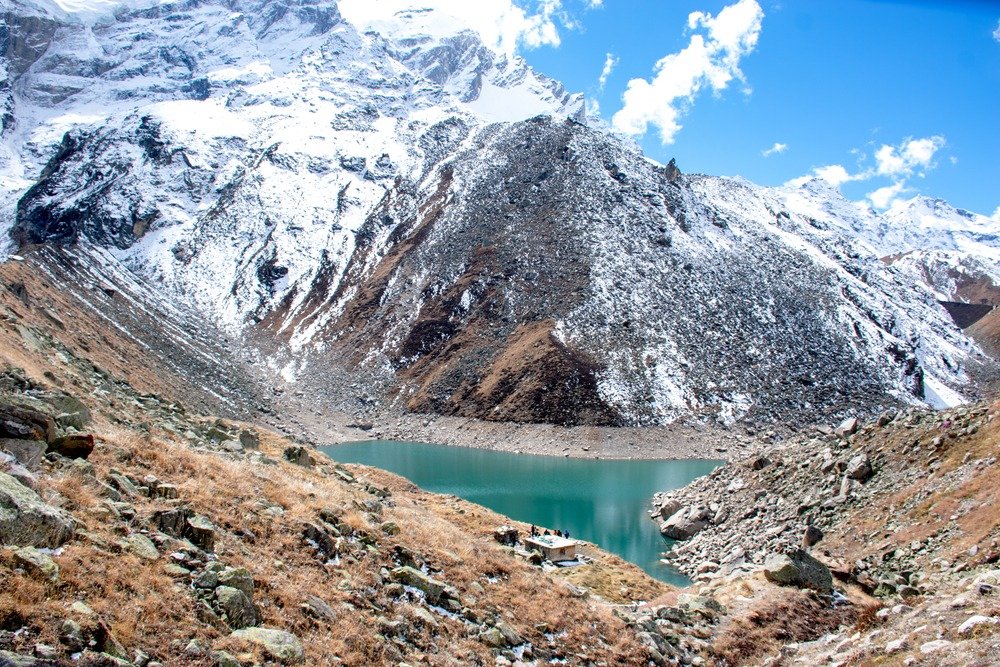If you’re looking for a trekking experience that combines awe-inspiring landscapes with spiritual reverence, look no further than the Satopanth Lake trek. Nestled deep in the Garhwal Himalayas, this trek offers a true test of your endurance, while also rewarding you with serene beauty and incredible views of the snow-covered peaks. Whether you’re a seasoned trekker or someone ready for a challenge, Satopanth Lake promises to be an unforgettable adventure.
In this article, I’ll guide you step-by-step through this unique trekking journey, sharing personal insights, tips, and experiences to make sure you are fully prepared to take on the beauty and mystery of Satopanth Lake.
Why Satopanth Lake Should Be on Your Bucket List
Satopanth Lake is not your typical trekking destination. While there are countless beautiful trekking spots in the Himalayas, Satopanth stands out for its combination of natural beauty and its deep mythological and spiritual significance. At an altitude of 4,600 meters, the lake sits high in the mountains, surrounded by majestic peaks and glaciers that add to its allure. What sets it apart, however, is the legend that it holds sacred to many—Satopanth is believed to be the spot where the trinity of Hindu gods—Brahma, Vishnu, and Shiva—meditated, making it a place of spiritual pilgrimage for many.
Aside from the rich mythology, the lake’s stunning landscape also draws trekkers from across the world. The pristine turquoise waters of the lake, flanked by the imposing Himalayan peaks, offer views that seem straight out of a dream. For any trekker with a sense of adventure and a love for the mountains, Satopanth Lake is an experience like no other.
Day 0: Pre-Trek Preparation – Gear Up for the Adventure!
Before embarking on such a high-altitude trek, it’s essential to prepare thoroughly, and packing is one of the most important aspects of that preparation. The key to ensuring you enjoy the trek and stay safe lies in the gear you bring along. Start by making sure your clothing is appropriate for changing weather conditions. The higher you climb, the colder and windier it gets. Layering is essential: pack moisture-wicking base layers, a good quality fleece or down jacket, and a waterproof outer layer. A waterproof and windproof jacket will be your best friend when dealing with unpredictable Himalayan weather.
Your trekking boots should be durable and comfortable, with good ankle support for those rocky and uneven paths. Trekking poles are also highly recommended, as they will help ease the strain on your knees, especially during the steep descents. Additionally, don’t forget the essentials like a first aid kit, sunscreen, and a camera to capture the magical moments of the trek. I’ve always found that a little extra preparation can make the difference between a comfortable trek and a challenging one, so make sure you’re fully equipped.
Day 1: Arrival in Badrinath – Welcome to the Gateway of the Gods!
Badrinath, the starting point of your trek, is not just a place for trekkers but a spiritual haven. As I arrived in this small town, nestled by the Alaknanda River and surrounded by towering peaks, I felt an immediate sense of calm. The town is famous for the Badrinath Temple, one of the Char Dhams of Hindu pilgrimage, dedicated to Lord Vishnu. After checking into my accommodation, I decided to visit the temple and take in the serene atmosphere. The sound of the gushing river and the sight of pilgrims praying at the temple made me realize that this journey wasn’t just physical—it was a spiritual one as well.
Badrinath sits at a high altitude, so acclimatization is key to avoiding altitude sickness. Even though the trek officially begins the next day, spending time in Badrinath helps your body adjust to the altitude. I recommend taking it easy and exploring the town slowly, soaking in the beauty and the calm. The spiritual vibe of the place will set the tone for the trek ahead, and by the time you head out on Day 2, you’ll feel ready for the adventure that awaits.
Day 2: Badrinath to Laxmi Van – The Journey Begins (8 km)
The excitement of finally starting the trek was palpable. Day 2 marks the official beginning of the Satopanth Lake trek. The trail from Badrinath to Laxmi Van is an 8-kilometer journey, offering trekkers a gentle yet scenic introduction to the trek ahead. As I began the walk, I was greeted by lush green meadows and tall alpine trees, with the towering peaks of the Garhwal Himalayas in the background. The beauty of the surroundings was intoxicating, and the fresh mountain air invigorated me every step of the way.
The path gradually ascends, but it’s not too challenging—just enough to get your legs warmed up for the steeper sections ahead. Along the way, you’ll cross small streams, and if you’re lucky, you might spot some Himalayan wildlife. The tranquil surroundings were perfect for reflection, and I found myself lost in thought as I continued towards Laxmi Van, the first camping spot. By the time I reached Laxmi Van, I felt a sense of accomplishment. The peaceful campsite, surrounded by dense forests, provided the perfect place to rest and enjoy a warm meal before turning in for the night.
Day 3: Laxmi Van to Chakrateerth – Nature’s Beauty on Full Display (10 km)
Day 3 of the trek is one of the most beautiful, yet physically demanding. The path to Chakrateerth is 10 kilometers, and the trail becomes more rugged, with several steep ascents. But don’t let that deter you—because the view that awaits you at the top makes every step worth it. As I climbed higher, I passed through wildflower meadows and dense forests, often stopping to catch my breath and admire the changing scenery. The further you get into the trek, the more isolated it feels—just you, the mountain trail, and the mighty Himalayas.
Chakrateerth, which means “the place of the chakra,” holds great religious significance. According to Hindu mythology, Lord Vishnu’s Sudarshan Chakra (his disc) is said to have fallen here, adding a sacred aura to the place. I paused for a moment of reflection, appreciating not just the beauty around me but the spiritual weight of the location. Sitting beside a river at Chakrateerth, surrounded by the peaks, I felt both humbled and awed. The clear water and calm atmosphere provided a moment of serenity that made the day’s efforts feel more than worth it.
Day 4: Chakrateerth to Satopanth Lake – The Ultimate Destination (5 km)
This is the day that makes the entire trek unforgettable—the journey to Satopanth Lake. The 5-kilometer trek from Chakrateerth to the lake is steep and challenging, but it is absolutely worth it. As I made my way up, I could feel the altitude affecting my breathing, but the sheer beauty around me kept me going. The landscape becomes more rugged as you near the lake, and the air grows thinner. The terrain is rocky, and the final stretch can feel like an intense test of endurance. However, every step brings you closer to the destination that has been calling to you for days.
Reaching Satopanth Lake was nothing short of magical. The crystal-clear waters, reflecting the towering snow-capped peaks, seemed surreal. I couldn’t help but stand there in awe. The lake is surrounded by three major peaks—Satopanth, Neelkanth, and Kuber—each adding to the sacred feel of the place. It was at this moment that I truly understood why this lake holds such religious significance. It felt like stepping into a place beyond time, a place where nature and spirituality exist in perfect harmony.
Day 5: Return Journey – Retracing Your Steps
After spending some time at Satopanth Lake, it’s time to begin the return journey. The path back is the same, but the perspective is entirely different. The landscapes, which you might have missed in your rush to the lake, take on a new beauty as the changing light of the day transforms them. While the descent to Laxmi Van is a little easier on the knees, it’s still a challenging 10-kilometer trek. But with the satisfaction of reaching Satopanth Lake, every step felt lighter.
The return journey also gave me time to reflect on the trek—the physical effort, the beauty of the Himalayas, and the spiritual journey I had just experienced. As I arrived back at Laxmi Van, I couldn’t help but feel an overwhelming sense of gratitude for the adventure I’d just had.
Day 6: Laxmi Van to Badrinath – Completing the Circle
The final day of the trek took us back to Badrinath. The 8-kilometer walk was relatively easy compared to the previous days, but there was a sense of finality to it. As I walked along the familiar path, I felt a mix of exhaustion and fulfillment. The trek had been physically demanding, yet incredibly rewarding. Once back in Badrinath, I spent some time reflecting on the journey. The beauty of the Himalayas, the challenge of the trek, and the spiritual significance of Satopanth Lake were experiences that I would carry with me for the rest of my life.
What Makes Satopanth Lake So Special?
Satopanth Lake is not just another picturesque destination—it’s a sacred site with profound religious significance. According to Hindu mythology, the lake is associated with the trinity of gods—Brahma, Vishnu, and Shiva—who are said to have meditated here. It’s believed that the gods used the lake as a place to test the purity of their followers, which adds an element of mystery and reverence to the site. For trekkers, this spiritual backdrop makes the journey even more profound.
The lake itself is as beautiful as it is sacred. Surrounded by towering Himalayan peaks and glaciers, the scenery is nothing short of spectacular. The water, which reflects the surrounding snow-capped mountains, has a mirror-like quality that feels almost otherworldly. Whether you are trekking for spiritual reasons or simply to enjoy the natural beauty, Satopanth Lake offers a deeply rewarding experience.
Best Time to Visit Satopanth Lake
The ideal time to visit Satopanth Lake is between May and September. During these months, the weather is usually clear, and the trekking conditions are favorable. The temperatures are cooler but not extreme, making it the best time for trekkers. However, it’s essential to keep in mind that the weather in the Himalayas can change suddenly, so being prepared for snow, rain, or even hail is important. If you’re looking to book your Satopanth Lake trek with a trusted company, I highly recommend The Searching Souls. They offer well-organized treks with experienced guides who ensure both safety and an enriching experience. From seamless transport arrangements to excellent camping facilities, they cover all the essentials, so you can focus solely on enjoying the adventure.
It’s also worth noting that the monsoon season (June to August) brings a higher chance of landslides and unpredictable weather, which can make the trek more challenging and dangerous. For the best experience, aim for the late spring or early autumn months when the skies are clear, and the trail conditions are optimal for trekking.
Conclusion – An Experience You Won’t Forget
The Satopanth Lake trek is not just a physical challenge, but a journey that combines the best of nature, spirituality, and adventure. Whether you’re in it for the incredible views, the physical challenge, or the chance to visit a sacred site, this trek will leave you with memories that last a lifetime. I can wholeheartedly recommend it to anyone looking for an unforgettable Himalayan adventure.
FAQs
1. How challenging is the Satopanth Lake trek?
The Satopanth Lake trek is considered moderate to challenging. It requires a good level of fitness and previous trekking experience, especially with high-altitude trekking.
2. Do I need to hire a guide for the trek?
Yes, hiring a guide is recommended. The trail can be tricky to navigate, and a guide will ensure you stay on course, manage the altitude, and provide valuable insights into the region.
3. What is the highest point of the Satopanth Lake trek?
The highest point is Satopanth Lake itself, located at an altitude of 4,600 meters (15,100 feet). This is where trekkers reach the pinnacle of the adventure.
4. How long does it take to complete the trek?
Typically, the Satopanth Lake trek takes about 6 days. This includes time for acclimatization and adequate rest between the trekking stages.
5. Can I do this trek solo?
While solo trekking is possible, it’s not advisable due to the remote nature of the trail and the challenging terrain. It’s best to trek with a group or hire a guide for safety reasons.
Please Read Article more – The Ultimate Packing List for Your Kedartal Trek Adventure



